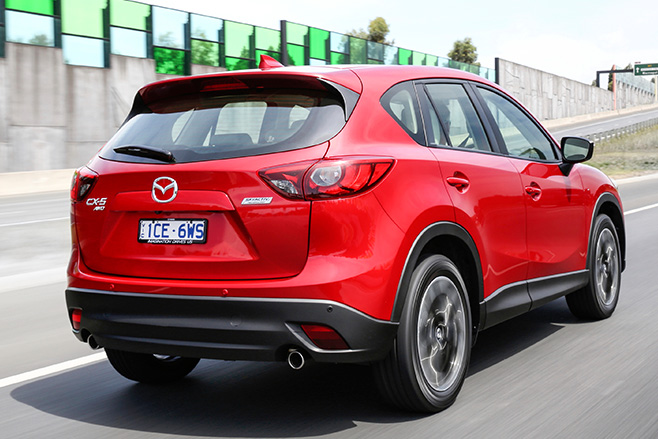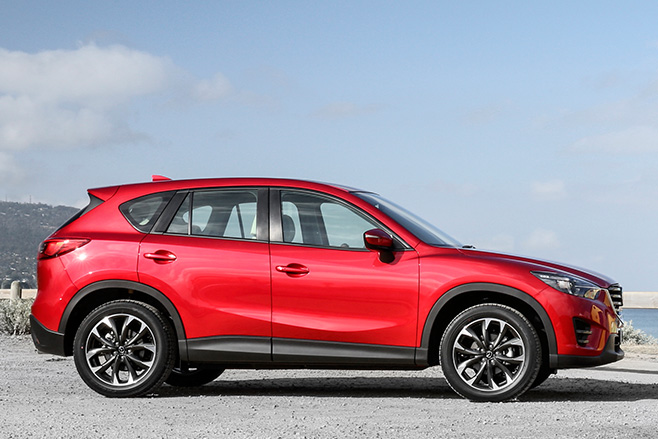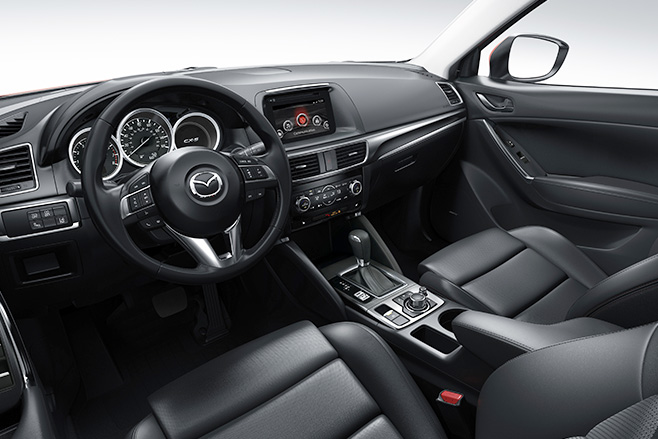
So, what is it?
After close to three years on sale, Mazda has given its mid-size CX-5 SUV a kick along courtesy of spec upgrades, some worthy engineering tweaks, and subtle changes to its appearance inside and out.
Why should I care?
The Mazda CX-5 is the country’s best-selling SUV, with local sales nudging towards 60,000 units since launch in Feb 2012. It was the first Mazda to reflect the brand’s distinctive ‘Kodo’ design language, and ‘Skyactiv’ engine efficiency, light-weighting and aero tech development. So Mazda will be keen to improve rather than upset a winning formula.

What’s new about it?
In terms of spec, the ‘MZD Connect’ system (web access, Bluetooth streaming, short text facility and internet radio accessed via seven-inch colour touch screen) is now standard across the range, an electronic parking brake replaces the previous mechanical set-up, allowing a smoother centre console treatment, and a reverse camera has been added to all models as well.
From an engineering point-of-view the suspension has been fine-tuned with a new support structure for the front and rear dampers and revised bushing shapes for the front lower arms. The claimed result is improved NVH performance and a more compliant ride.
Petrol models (2.0 and 2.5-litre fours) now feature ‘Drive Selection’, accessed via a console toggle switch. Sport mode sets the transmission to automatically select first gear from rest, and from there increases the amount of torque delivered for a given amount of accelerator pedal travel.
According to Mazda CX-5 design chief, Akira Tamatani, the tweaks he and his team have applied enhance the car’s “strength and boldness”, for “even greater on-road presence and quality feel.”
While there are no sheet metal changes, the grille opening now features broader metallic grey fins, new headlights feature LED lighting in Kodo’s leopard-eye signature (as do the rears), and high-spec models ride on new-design 19-inch alloy rims.

That’s all fine. What’s it like to drive fast?
The launch drive program covered a series of classic winding backroads in and around the Yarra Ranges National Park, roughly 100 kays north east of Melbourne, and we steered a mid-range Maxx Sport 2.5-litre petrol, and the 2.2-litre turbo diesel in top-spec Akera trim; both AWD.
When it slotted in beside the base CX-5’s (114kW/200Nm) 2.0-litre in 2012, the (138kW/250Nm) 2.5-litre petrol engine delivered a welcome performance boost, but its grunt profile is still best described as adequate. Even in Sport mode, the six-speed auto needs to dig deep into its bag of ratios to cough up the performance required for rapid highway overtaking.
The 2.2-litre diesel cuts through all that with a hefty 420Nm on tap from just 2,000rpm, and 129kW available more than 1,000rpm lower than the 2.5 petrol. It’s a quick and comfortable highway cruiser, with appreciably better (claimed) fuel economy to boot.
Steering feel and response remain excellent, and the car is composed and predictable in quick cornering. Braking is progressive and powerful.

And driving from home to the office in the city?
Ride comfort is indeed better, although it wasn’t exactly terrible to begin with, and noise levels are lower. Front and rear seats have been subtly re-profiled, and the result is extra grip without any comfort penalty.
The interior freshen-up is built around a reorientation of the main centre stack elements from vertical to horizontal, with a range of stain chrome and brushed metal finishes added. Classy and functional, the cabin is a cool and comfortable environment.
Is there anything bad about it?
We like the digital speedo located within the rev counter on other Mazda models, but the current CX-5’s electronic architecture doesn’t allow it. Pity.
How much would I have to pay for one? And is it worth the coin?
There are three primary model grades, Maxx, GT and Akera, with Safety, Sport and Sport Safety extensions available on Maxx and GT.
Pricing starts at $27,190 for the 2.0-litre, FWD Maxx with six-speed manual transmission (the only level with manual trans available), climbing to $50,610 for the Akera diesel. Equipment levels are high, and pricing competitive across the range. Solid value.
Would you take the Mazda CX-5 or the Nissan X-Trail?
Pricing is line-ball, the Nissan offers a seven-seat option, and now, diesel power. We’d still opt for the Mazda because it’s a more enjoyable drive.
Click here to read the full review on the Mazda CX-5.



